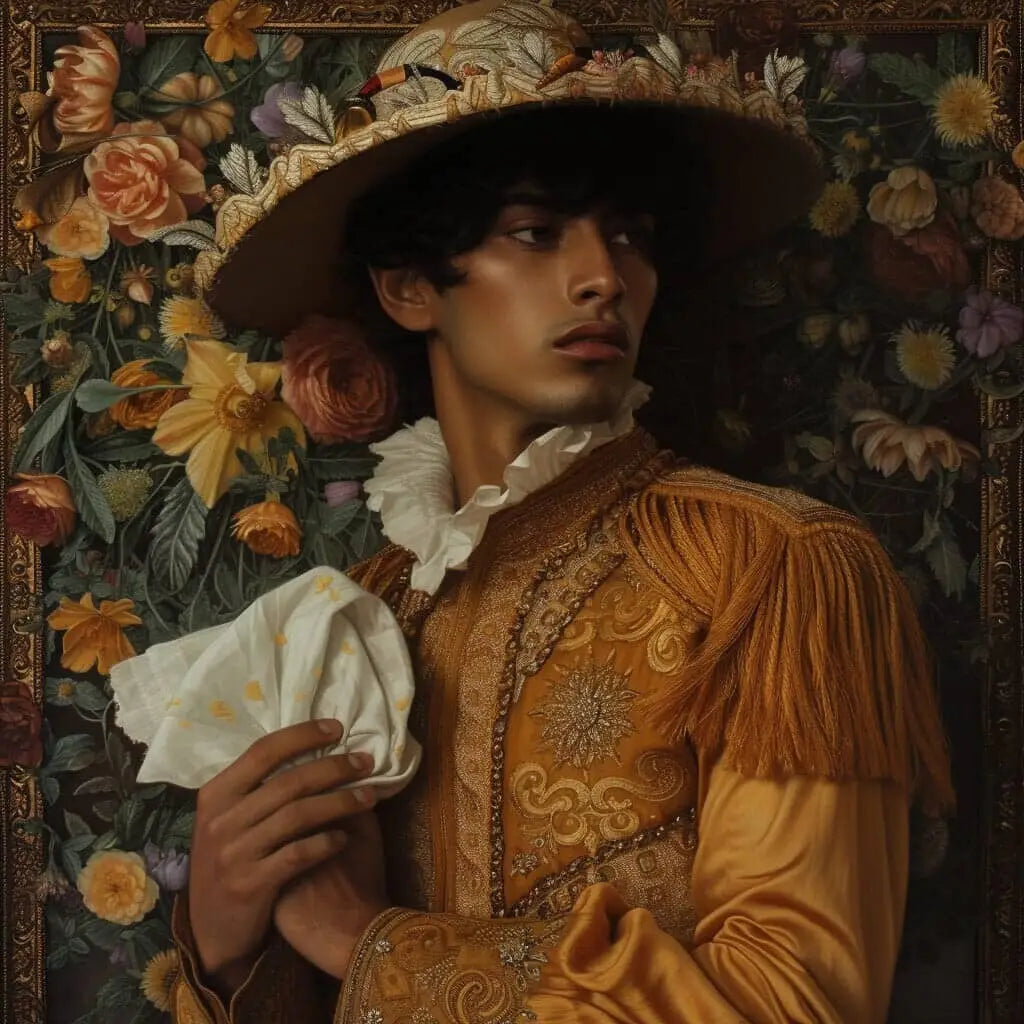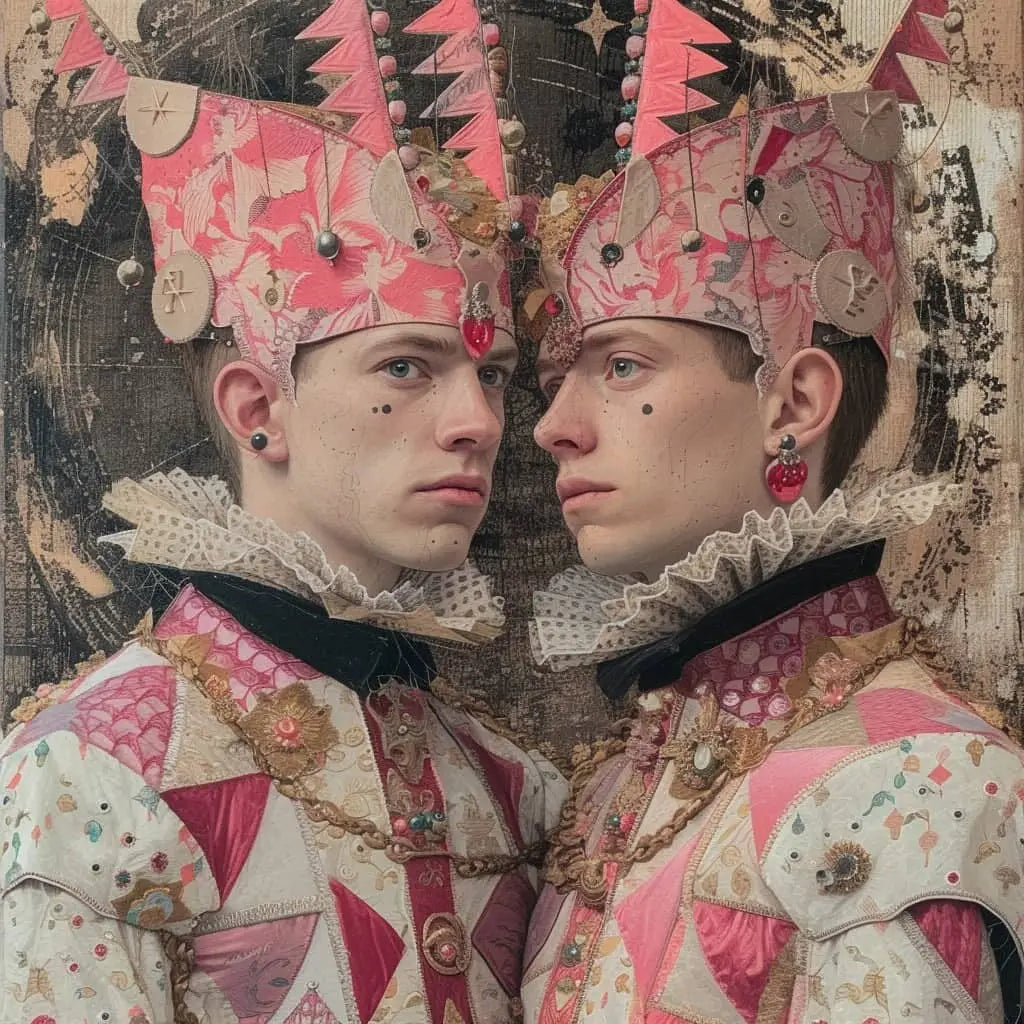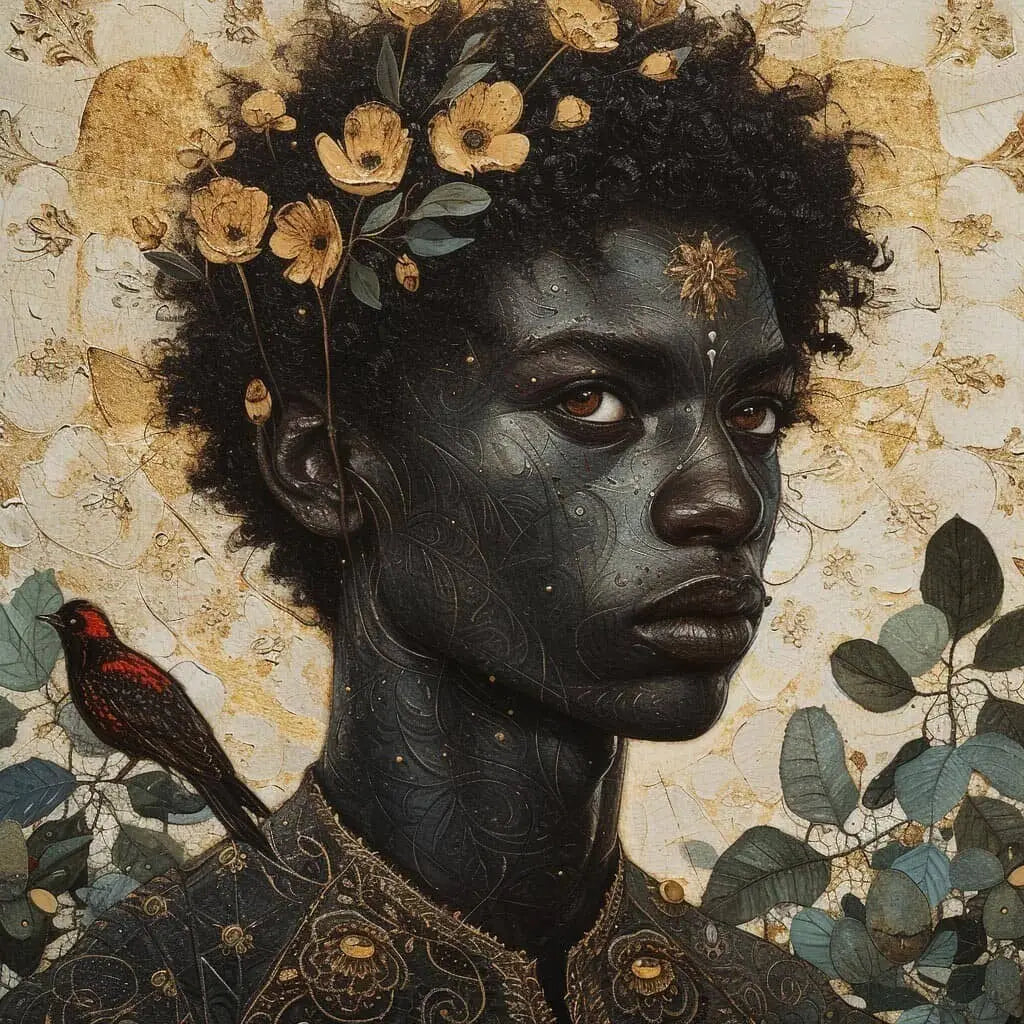Hidden Queer Symbols in Art History, Culture and More Stuff Queers Are Great At...
Queer coded symbols in art history have made it possible for creative queers to share a little of their true selves when speaking openly about their queerness could get them killed. Still can. Not that it stopped queer folks through the ages being f**king fabulous. Nothing could ever stop that. And besides... queers like codes. Cliques, you might say. At the very least... they're often a ton of fun.
Coded visual language has been significant in gay art through history. But all the queer coded symbols in art history we'll be examining are concentrated in the last couple of hundred years. Why? The notion of sexual identity is a relatively recent invention, which dates to the late nineteenth century and is tied to the formation of modern science and medicine. Most notably in modern contexts due to the criminalization of homosexual acts and the social stigma associated with homosexuality.
Now let's get on and explore a bunch of queer coded symbols in art, history and culture at-large. Each with their own curious mystique. Being signs of self expression, freedom of thought and symbols of Otherness made diviiiiiine.
What Is Queer Art, Exactly? Or Even Thereabouts...
For the purposes of this post, queer art refers to the art of gay, lesbian, bisexual, transgender, and intersex people. Darting from photography to portraiture, abstract painting to sculpture and the chaotic order of collage and mixed media.
To unmask it, to let it breathe in the open air, one must peer deeper into the history of artistic creation, uncovering the hidden gems obscured by the weight of history and the bitter sting of prejudice. And each new medium, every shift in style, offers a fresh opportunity to explore the depths of identity against the beautiful, unpredictable nature of our one brief life.
Back to the good news: (most) queer artists don't give a damn about the worn-out stereotypes we've been sewn into. So many examples of queer art through history have shown how to learn the rules so you can break them. Reshaping them. Creating something fresh and alive and free. Queer artists have almost always been the rebels, the pioneers, the ones who stare at the world and say, "No, not like that. Like this." And in doing so, they give voice to the voiceless. A visual language for those who refuse to be silenced. Which is why queer art remains a powerful political and celebratory way of capturing gay, lesbian, bisexual, transgender, and intersex people's lived experiences to this day.
1
The Green Carnation

The green carnation became a popular symbol of queer identity when Oscar Wilde instructed his friends to wear them on their lapels to the premiere of his play 'Lady Windermere's Fan' in 1892. The green carnation served as a symbol of queer pride and was a way for Wilde and his circle to identify each other discreetly.
The green carnation was also associated with the Aesthetic movement, which celebrated beauty and art for art's sake. The flower embodied the decadent, the unnatural, and the artistic. Some folks even say these "unnatural" green carnations, worn with a wink and a smile, were a sly way for gay men to thumb their noses at uptight Victorians. A secret language. A bold statement hidden in plain sight. A splash of color and rebellion, daring to defy the world that kept their love (and desires) in the shadows. And as they wore their green carnations, they carved out a space for themselves, a place where love could bloom, no matter the color or form it took.
A number of organizations still use the name or iconography of the green carnation today.
Queer Coded Green Carnations
Green Carnations in Literature- "The Green Carnation" by Robert Hichens: This novel, first published anonymously in 1894, is a satire on contemporary champions of the Aesthetic Movement. It was briefly withdrawn after the scandal of the Oscar Wilde trial in the following year.
- "The Green Carnations: Gay Classics Boxed Set": This collection celebrates Wilde and other authors from the past who represented gay love and desire in their work. The set includes The Picture of Dorian Gray, Joseph and His Friend, Cecil Dreeme, The Sins of the Cities of the Plain, and others.
- "An Ideal Husband" (1999): In this film, the green carnation that Arthur selects for his buttonhole is a subtle homage to Oscar Wilde. Wilde and his "inner circle" of gay friends used to wear green carnations as a way of discreetly displaying their sexuality.
- "The Green Fog" by Guy Maddin: Ok... no green carnations, but this experimental documentary looks through the fog of gay cultural history with a nod to the queer coded flower.
Other Flowers That Have Become Queer Symbols
Other flowers that have been used as symbols of queer identity include violets, which have been associated with lesbian love since the 6th century thanks to the work of the Greek poet Sappho from the isle of Lesbos. Pansies were also used as a symbol for flamboyant gay men in the early 20th century, during the "Pansy Craze". The term "pansy" was used as a homophobic or transphobic slur, but many activists and artists have since taken ownership of the term and changed its derogatory meaning.
Flowers have often been used by queer artists to symbolize beauty, sensuality, and a celebration of difference, transcending time and place. It's no surprise, then, that flowers have been a recurring motif in queer art. From Karl van Vechten's photography of Harlem residents in the 1930s and 40s, and Robert Mapplethorpe's black and white flower photography.
2
Peacock Feathers

The use of peacock feathers as a symbol of queer identity came about in the late 19th and early 20th centuries. In the Victorian Aesthetic Movement, fashionable symbols were the playful language of the day. Flowers, handkerchiefs and fans acted like secret agents in a world of gray. A celebration of self-expression and connection. Helping men and women find joy and camaraderie in the most unexpected places.
The male peacock's flamboyant tail feathers were seen as a representation of non-heteronormative beauty. Men would wear peacock feathers to identify themselves to other homosexual men, and artists would incorporate the feathers into their artwork as a subtle way to signal their sexuality. All around the same time as the green carnation was a popular symbol of gay male identity, thanks to Oscar Wilde.
The male peacock's flamboyant and extravagant appearance, which is more striking than the female peahen's, also contributed to the association of peacock feathers with queer identity.
Queer Coded Peacock Feathers
One example of peacock feathers being used as a queer symbol in art is Edmund Dulac's painting "Charles Ricketts and Charles Shannon as Medieval Saints" (1920). In this painting, Charles Shannon is depicted holding a peacock feather, juxtaposing religious imagery with a knowing symbol of queer identity. The masterful composition not only captures the eye but also invites the observer to explore the layers of significance, as the painting becomes a visual conversation between the overt and the clandestine.
3
The Hanky Code

The gay male hanky code, or flagging, is like a secret handshake. A colorful wink and nudge for those in the know. The hanky code involved wearing different colors of bandanas in your pockets to indicate different kinks, sexual preferences, and roles, such as top/dom or bottom/submissive.
The hanky code originated in San Francisco in the 1970s, where the wearing of colored bandanas as a practical accessory was common among gay men. Creating a significant impact in the history of gay culture by allowing gay men to communicate their sexual preferences and desires in a discreet and nonverbal way — during a time when homosexuality was stigmatized and criminalized.
Just a swatch of fabric, a little splash of color tucked away, and suddenly, you're telling a whole story about what you're into, like a walking billboard for desire. A clever way of chatting without saying a word, making connections and finding your tribe in the swirling chaos of life.
The hanky code also helped to create a sense of community and belonging among gay men, who could identify and connect with others who shared similar interests and desires. The hanky code has since undergone a revival and is still used today in some LGBTQ+ communities, although the use of handkerchiefs specifically may not be as prevalent as it once was.
The Hanky Code in Queer Art and Culture
The Hanky Code in Art
- Hal Fischer's "Gay Semiotics": depicted the meaning of each color in handkerchiefs stuffed in the back pockets of gay men. His work has been recycled, referenced, and reissued in iterations nd exhibitions to the present day.
- Queer Ecology Hanky Project: involves over 125 artists who have designed, printed, and distributed bandanas as wearable artwork. The project expands the definitions of the original gay hanky code to include different bodies, identities and activities.
- Brad Guy: created a photo series teaching about the hanky code, providing a visual exploration of this unique aspect of queer culture.
Hanky Code Guide
- Yes I'm Flagging: Queer Flagging 101 by Archie Bongiovanni: This illustrated zine is all about the nonverbal ways we can communicate about our desires for some casual nsfw fun. It includes the history of flagging and the nuance between various shades.
Hanky Code in Film
- "Hanky Code: The Movie" (2015): This is an epic anthology feature film event combining 25 shorts from different queer directors worldwide, each telling a story based on a color/fetish of the infamous hanky code.
4
The Pink Triangle

The pink triangle began in the shadows — originally used by the Nazis in concentration camps to identify and shame homosexuals. Gay men were forced to wear the pink triangle on their breast pockets to set them apart from other prisoners and to subject them to further persecution and violence from other inmates. The pink triangle was as a weapon.
As the war drew to a close and the concentration camp gates were flung open, a bittersweet moment unfolded. Most prisoners were set free, embracing a chance to rebuild their lives. Yet, for the gay male prisoners adorned with the pink triangle, their journey was not yet over.
These men, still bearing the mark of their perceived difference, were cast back into the shadows, returning to prison and facing ongoing persecution. A sobering reminder that, while the world may change, the path to acceptance and understanding has been a long and winding road, fraught with challenges.
Ultimately, the pink triangle found its way to the light. With the LGBTQ+ community reclaiming it and turning it into a beacon of hope and pride. Becoming emblematic of life and death during the AIDS epidemic of the 1980s and 90s. Used as a universal symbol of LGBTQ+ pride and an international declaration of resilience and demands for justice. A metamorphosis that demonstrates the power of transmuting pain into triumph.
The pink triangle has been used in LGBTQ+ rights demonstrations worldwide. Serving as a reminder of the atrocities committed against LGBTQ+ people in the past, and as a symbol of the ongoing struggle for equality and acceptance around the world.
The Pink Triangle in Queer Art and Culture
The Pink Triangle in Literature
- "The Men With the Pink Triangle" by Heinz Heger provides a vivid account of the persecution of gay people in Nazi concentration camps.
- "Branded by the Pink Triangle" by Ken Setterington, also explores this history and the transformation of the pink triangle into a symbol of gay rights.
The Pink Triangle in Film
- "The Pink Triangle" (2020), a movie that tells the story of a gay Nazi soldier struggling to keep his identity hidden.
- "The Rocky Horror Picture Show" also features the pink triangle, worn by the character Dr. Frank N. Furter.
The Pink Triangle in Art and Graphic Design
- The activist-artists of the group ACT UP adopted the pink triangle as a powerful logo for AIDS activism worldwide in the 1980s.
5
Classical and Mythological Identities

Queer artists throughout history have employed coded visual language that would not arouse suspicion among the general public, but would allow those familiar with the tropes of the subculture to glean the hidden meaning. In days of yore, the whole idea of queer love was viewed entirely different to the way we see it now. So the Gods and Goddesses and every deity in between wouldn't have even thought of gender that way in the first place. Just look at all the queerness in Greek and Roman mythology. And plenty more queer lore from days of yore. Oh yes. And from cultures aaaaaaall across the globe.
Still, despite all that queerness in just about every culture across the world for a time... times changed. And when queer folk couldn't express their love openly anymore, they found clever approaches to say what they meant without revealing it explicitly. Disguising their passions in masks like the ancient, enthralling tales of Greek mythology. Frederick Leighton’s “Daedalus and Icarus” is a clear example — hinting at the sexual relations between older mentors and young men in Ancient Greece.
The Olympian Gods got up to all sorts of queer shenanigans, and their position in the Western canon has given artists license to connect their own desires with socially acceptable tropes through these figures. A way to pour their hearts out while dancing around the edges of societal norms. Allowing queer audiences of the time to find meaning and connection through the work.
Classical Queers in Art and Culture
Queers in Ancient Cultures and Classical Mythology
- Apollo and Hyacinthus: In Greek mythology, Apollo, the god of sun and music, had a romantic relationship with a handsome youth named Hyacinthus. Their story is a tragic one, as Hyacinthus dies due to a discus thrown by Apollo, which was blown off course by the jealous wind god Zephyrus.
- Achilles and Patroclus: The Iliad by Homer depicts a deep, intimate bond between Achilles and Patroclus. While the nature of their relationship is subject to interpretation, many believe it to be a representation of same-sex love.
- Hadrian and Antinous: Roman Emperor Hadrian's love for Antinous, a Greek youth, is well-documented. After Antinous' premature death, Hadrian deified him, and his image was widely disseminated throughout the empire.
- The daring Mayan god Chin introduced homoeroticism to Mayan culture, igniting a flame of same-sex love. His audacious example inspired noble families to pair their sons off with other young men, forming something of a matrimonial bond.
- In Inuit mythology, the first two humans were Aakulujjuusi and Uumarnituq, both men. They fall head over heels in love and in a twist of magic, Uumarnituq transforms and bears their child. A child whose birth also kinda sorta brought forth the art of war. To balance the great magical force that was created when a love so great made the impossible, possible. But still... war. It doesn't make a lotta sense, but also... all the sense in the world. And you gotta love that about gods in general — from Rome to the Northwest Arctic. They play by their own rules, just like most of us queers do to this very day.
Queers in Classic Literature
- "The Picture of Dorian Gray" by Oscar Wilde: While not overtly gay, the novel is filled with homoerotic subtext. The characters Basil Hallward and Lord Henry Wotton express intense admiration for Dorian Gray's beauty.
- "Maurice" by E.M. Forster: Written in 1913-14 but published posthumously in 1971, this novel tells the story of Maurice Hall, who comes to terms with his own homosexuality in a society where it is stigmatized.
Queers in Art History
- Michelangelo's Sonnets: Michelangelo's sonnets to Tommaso dei Cavalieri, a young nobleman, are considered by many scholars to express romantic and erotic love.
- Renaissance Art: Some Renaissance artists subtly incorporated allusions to homosexual love in their paintings. For instance, Leonardo da Vinci and Michelangelo, both of whom are believed to have been homosexual, have works that are interpreted as containing homoerotic subtext.
6
Polari: The Secret Language

Polari is a secret language that was spoken by gay men, drag queens and many more outsider subgroups in the UK from the 1930s to the 1960s. It allowed folks to communicate with each other discreetly and without risk. Incorporating an evolving mix of ingredients from Romance languages, Romani, Cockney rhyming slang and the codes of sailors and thieves. With words borrowed from Yiddish and 1960s drug subcultures, too. But it did have a small core lexicon and two main versions: one Cockney rhyming slang version + a "West End" version that stressed theatrical and classical influences.
Polari grew out of the world of entertainment, stretching back from West End theatres, through to 19th-century music halls and beyond that to the circus and fairground showmen. So it was never just used by the gay community. Polari was spoken in London fish markets, the theatre, fairgrounds, and circuses. The gays used it at a time when homosexual activity was illegal... probably because it's fun, too, but that's harder to factually verify. Subjectivity and all.
Polari has had a significant cultural and artistic impact, with many of its terms being adopted into regular British slang, modern LGBTQ slang and filtering down into mainstream slang. It has seen a renaissance in recent years as young LGBT people are eager to learn Polari and discover their cultural heritage.
Polari in Queer Art and Culture
Polari in Art
- The works of artist Zackary Petot use this codex language in combination with drawing, printmaking, and digital techniques, lending the language a contemporary flair.
- The language has also been adopted in the ceremonies of a group of male nuns called the Sisters of Perpetual Indulgence.
Polari in Literature
- "Fabulosa!: The Story of Polari, Britain's Secret Gay Language" by Paul Baker provides an in-depth exploration of Polari's linguistic origins, its usage, and how it fell out of fashion post-1967.
- "Polari - The Lost Language of Gay Men" by Paul Baker, also delves into the history and usage of Polari.
Polari in Film
- In the 2015 short film "Putting on the Dish", two men strike up a conversation on a park bench about life, sex, and the hostile world they find themselves in as gay men, speaking entirely in Polari.
- The 1998 film "Velvet Goldmine" also features two characters speaking Polari in a London nightclub.
—
Conclusion: The Trailblazing Art of Gay Symbolism
The history of hidden queer symbols in art is a testament to the resilience and creativity of LGBTQ+ artists. Through their use of visual codes, secret languages, and re-appropriation of imagery, these artists have managed to express their identities and desires, despite the challenges they faced. Today, as queer art continues to evolve, it is important to recognize and celebrate the contributions of these trailblazing artists who have paved the way for future generations.
•


